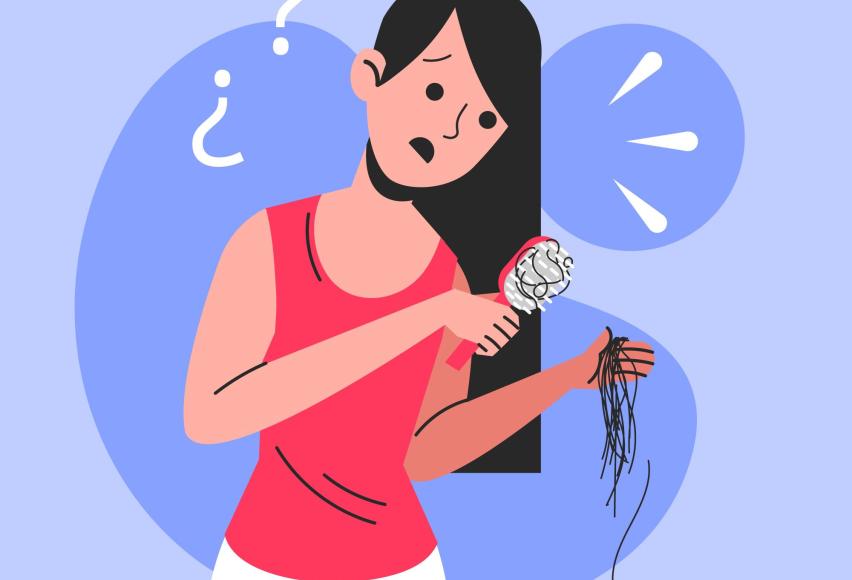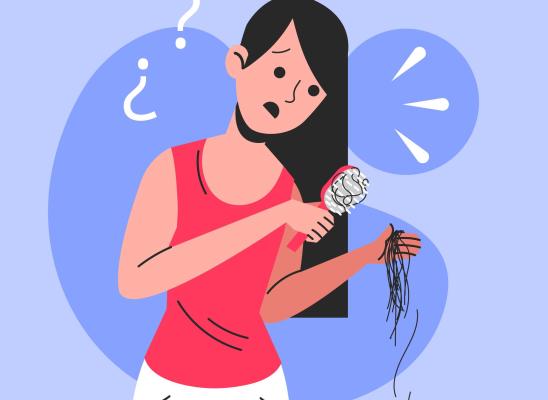Why Am I Pulling My Hair? What You Can Do About Urges

Online test
Find out the severity of your symptoms with this free online test
Why do I have a bald spot? Have my eyelashes always been this sparse? What happened to my eyebrows?
You may know that you pull your hair. You might pull without even realizing it.
If this sounds familiar, you might have a condition known as trichotillomania (TTM). TTM, commonly referred to as trich or hair pulling, is a body-focused repetitive behavior (BFRB) characterized by repetitive hair pulling usually from the scalp, lashes or eyebrows. It results in noticeable hair loss, significant emotional distress and problems with interpersonal functioning. TTM is classified as an Obsessive-Compulsive Related Disorder (OCRD), similar to OCD.
People with TTM experience intense urges to pull their hair. Sometimes they are highly aware of the urges. For others, their pulling is often done without awareness, resembling trance-like pulling behavior. For some people, the urge to pull can be quite intense, and even irresistible, even when you don’t want to pull.
Just why do urges happen? What’s the experience like for people who experience them? And is there anything to do about them?
Why Do We Get Urges to Pull?
Hair pulling is thought to be an attempt to reduce or avoid unpleasant, negative feelings or sensations. There’s even evidence that suggests that hair pulling may also be a trauma response. Experiential avoidance is engaging in unhealthy behaviors to escape or avoid unpleasant internal psychological experiences (e.g., fear, anxiety). While effective in alleviating distress in the short-term, the avoidance behavior (in this case, hair pulling), doesn’t eliminate the source of the distress. Over time, the response becomes the person’s “go-to” response.
What triggers urges isn’t the same for everyone and the experience varies. Some people find that certain feelings can trigger their urges. Others find that certain sensations can fuel the urge to pull. One study identified five broad categories of antecedents (triggers) to pulling:
- Bodily sensations
- Physical symptoms
- Mental anxiety
- General uncomfortableness
- Thoughts, ideas, and images
General uncomfortableness was the most frequently cited antecedent to hair pulling, followed by bodily sensations, physical symptoms, mental anxiety, and thoughts, ideas, and images. These results seemed to be consistent regardless of the person’s preferred area to pull hair from.
Cognitions or thoughts about the hair such as ‘‘feels coarse’’, ‘‘doesn’t feel right’’, ‘‘is curly’’, or ‘‘doesn’t look right’’ have been found to be particularly strong. Anecdotal evidence supports the variety of triggers to pulling. Many people who openly share their stories describe dealing with emotional issues such as anxiety, stress, and depression.
Some urges are sudden and intense. Others come on gradually.
- Gradual urges come on slowly and build in intensity. These urges are easier to address and there are a number of strategies for dealing with them.
- Sudden urges, as the name implies, come on quickly and can be quite intense. They require a pre-planned response to deal with them when they occur.
In a recent Trichstop.com webinar, Dr. Vladimir Miletic discussed dealing with urges to pull. He noted that proactive measures and prevention when possible may be the best choice.
Know Your Triggers
The first step in dealing with urges is understanding what your triggers are. Some triggers may be well-known to you and precipitate sudden urges.
Other triggers may be less apparent. Gradual urges may feel like they come on quickly due to many less apparent triggers, what Dr. Miletic refers to as “mini triggers”.
Knowing your triggers can help you to make a plan to deal with your urges before they become irresistible. Identifying triggers is also an integral part of Habit Reversal Training, the gold standard approach for treating hair pulling.
A great strategy for learning to understand your urges and triggers is through journaling. Pay attention to what the experience feels like. Journaling can help you to gain insight into your urges and what needs they may be meeting. Other strategies you can use include mindfulness techniques such as body scanning, and visual imagery or artwork to explore urges. Each time, you’re collecting pieces of a puzzle to help you understand your urges to pick, and what needs they may be serving.
Make Your Plan
What your plan to deal with urges looks like will be different from another person’s plan. The goal is to simply to reduce the urge, so you don’t pull. Keys to a successful plan include:
- Keep it simple. Use strategies that are easy to implement.
- Practice so that you’re prepared when an urge appears.
- Set realistic expectations. You may not completely alleviate the negative feelings or sensations.
- Practice acceptance and equanimity. Equanimity is the ability to experience intense feelings but not act upon them using habitual responses. When you’re able to do that, you are able to ask, “What do I need right now?” “What is this sensation telling me?”
- Be kind to yourself. Avoid self-judgment.
- Get an accountability partner.
Strategies for Dealing with Urges
Urges are not all-or-nothing or constant. People living with trich report that their urges ebb and flow. One person who has written about their experience with hair pulling describes their urges as “seasons”.
Effective strategies can help you make a plan that works over time. Here are a few strategies that can help when the urges come:
Breathing exercises – Breathing helps your body relax and it increases mindfulness and awareness. Breathing can be especially effective for those sudden urges. There are many types of breathing exercises. Box breathing is a popular example. Choose the one that feels right for you.
Grounding exercises – Grounding helps you to find a sense of safety or “solid ground” while the urge lasts. While not as effective as breathing for sudden urges, grounding can be particularly helpful for gradual urges when used early. A few examples of grounding might be:
- Pressing your palms together
- Drawing or doodling
- Clenching and releasing your fist
Physical actions – Similar to grounding exercises, these are intentional physical actions that can help you focus and relax.
- Place one hand on your chest and the other on your abdomen. Focus on the skin-to-skin sensation.
- Entangle your fingers and hold for a few minutes.
- Give yourself a hug
Phrases of compassion – Similar to a mantra, use phrases that are meaningful and offer compassion. Practice them so that you have them handy when you need them. Avoid “affirmations” unless you’re sure they work for you.
Urges happen. Knowing what to do when they occur and knowing that you are not alone in your experience can help you to get through that time and work towards healing. Learning about trich from those who live with it and knowing that there are things you can do fosters understanding and creates a sense of connection and community. You are not alone.
References
1. Özten, E., Sayar, G. H., Eryılmaz, G., Kağan, G., Işık, S., & Karamustafalıoğlu, O. (2015). The relationship of psychological trauma with trichotillomania and skin picking. Neuropsychiatric disease and treatment, 11, 1203–1210. https://www.ncbi.nlm.nih.gov/pmc/articles/PMC4440428/#b23-ndt-11-1203
2. Wetterneck, C., Singh, R. S., & Woods, D. W. (2020). Hair pulling antecedents in trichotillomania: Their relationship with experiential avoidance. Bulletin of the Menninger Clinic, 84(1), 35–52. https://guilfordjournals.com/doi/10.1521/bumc_2020_84_01
3. Duke, D. C., Bodzin, D. K., Tavares, P., Geffken, G. R., & Storch, E. A. (2009). The phenomenology of hairpulling in a community sample. Journal of Anxiety Disorders, 23(8), 1118-1125. https://www.sciencedirect.com/science/article/abs/pii/S0887618509001467?via%3Dihub
4. Trichstop.com. (2022, April). Dealing with Intense Urges [Video]. YouTube.
https://www.youtube.com/watch?v=pZNXsBWeetA
5. Trichstop.com. (2021, July). Understanding the Urge to Pick [Video]. YouTube. https://www.youtube.com/watch?v=ZYpVisEZmNc
6. My trichotillomania hair pulling story (and resources). (2022, August 1). Little Miss Momma - life lessons from Ashley Stock - a momma-in-training. https://www.littlemissmomma.com/2022/08/my-trichotillomania-hair-pulling-story-and-resource-list.html
Online test
Find out the severity of your symptoms with this free online test
Start your journey with TrichStop
Take control of your life and find freedom from hair pulling through professional therapy and evidence-based behavioral techniques.
Start Now



